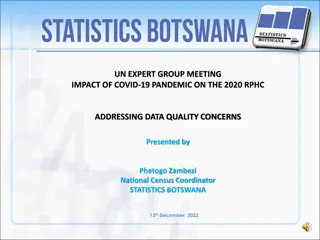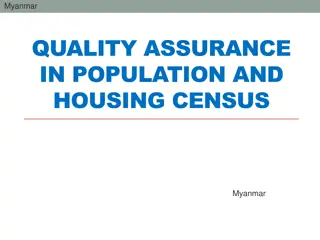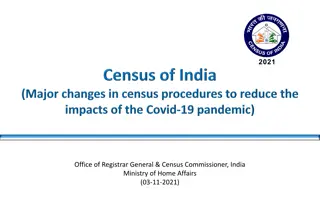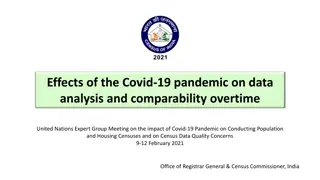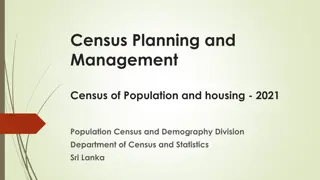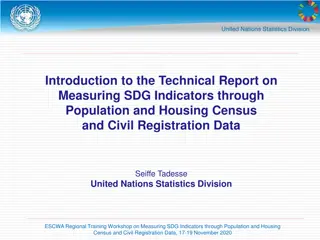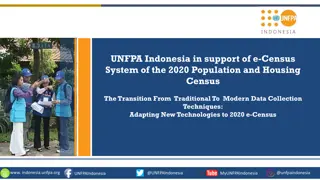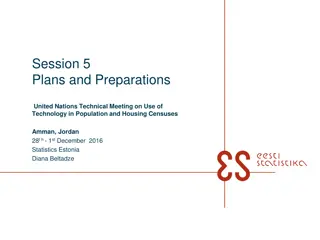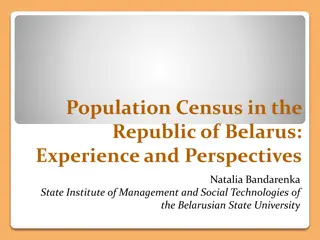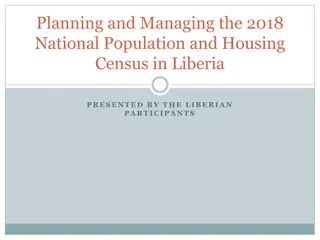Population and Housing Census Process in The Gambia
In The Gambia, the Population and Housing Census is conducted in April during the dry season for accessibility. A detailed mapping process was undertaken using modern technology to prepare for the census. Census instruments were carefully designed, and a pilot census in 2012 helped refine the process. Extensive training was provided at various levels to ensure accurate data collection and minimize errors. The focus was on identifying enumeration areas, understanding question modules, and maintaining data consistency.
Download Presentation

Please find below an Image/Link to download the presentation.
The content on the website is provided AS IS for your information and personal use only. It may not be sold, licensed, or shared on other websites without obtaining consent from the author.If you encounter any issues during the download, it is possible that the publisher has removed the file from their server.
You are allowed to download the files provided on this website for personal or commercial use, subject to the condition that they are used lawfully. All files are the property of their respective owners.
The content on the website is provided AS IS for your information and personal use only. It may not be sold, licensed, or shared on other websites without obtaining consent from the author.
E N D
Presentation Transcript
QUALITY MEASURES IN 2013 QUALITY MEASURES IN 2013 POPULATION AND HOUSING POPULATION AND HOUSING CENSUS CENSUS
Introduction In the Gambia, Population and Housing Census are conducted in April. This is the midst of the dry season when every part of the country is accessible. The objective is to count every one everywhere in The Gambia and every house everywhere in The Gambia. A comprehensive nation-wide mapping started two years before the census using modern cartographic and GIS technology. The mapping teams took a quick count of the population of every household during the mapping for purpose of comparison with the actual census count. The enumeration areas (EAs ) were delineated such that the average size of the EA was 500 persons. This was to avoid overloading the enumerators and every enumerator was assigned to an EA.
Introduction Contd Maps were produced at EA, settlement and district levels. For every EA, the boundaries were distinct with GIS coordinates of all compounds/structures within clearly shown and can be easily verified on the ground. Furthermore, mapping staff were deployed in all Regional Census Offices (RCOs) to assist in identification of EA boundaries.
Census Instruments Census Instruments Every effort was done not to overload the census questionnaires. The link between modules and the flow of questions were considered in the layout of the main questionnaires. As much as possible, questions were made simple and unambiguous. The questions were printed on one side of the page for ease of work and referencing. Manuals were developed to guide the enumerators, supervisors and entire field staff in administering the census questionnaires.
Pilot Census Pilot Census A pilot census was conducted in 2012 to test all aspects of the census for adequacy and relevance. Based on the outcome, appropriate adjustments were done in some modules and questions.
Trainings Trainings Training was conducted at three levels prior to the census enumeration all geared towards minimising content and coverage errors in the data collection. At the first level, staff to be deployed at the Regional Census Offices were trained at central level on all the instruments to used in the census. Emphasis was laid on the identification of EA boundaries, observation of skip patterns for some questions (eg economic characteristics) and checking the consistency to responses of certain questions such as fertility.
Trainings contd Upon deployment, staff of the Regional Census Offices recruit trainers in their respective regions whom they trained intensively at the second level. At the third and final level, all the Regional Census Offices recruit in their regions for data collection training based on set criteria. Those recruited were intensively trained by the regional trainers. The trainings include mock interviews among trainees in the various local languages. A standard written assessment was administered in all the regions and final selection was based on performance at that assessment.
Supervision of Data Collection Supervision of Data Collection Every 5 enumerators were assigned to a supervisor who observe each enumerator conduct interviews in at least 5 households. In addition the supervisor took a sample of each enumerators work for verification/editing with emphasis on the observation of skip patterns and consistency checks. Enumerators whose performances were not satisfactory were withdrawn early and replaced from the pool of floating enumerators.
Data Quality Checks Data Quality Checks A post enumeration survey (PES) was planned to be conducted shortly after the census enumeration. However, due to resource constraints, this could not be taken. In the absence of a PES, demographic techniques were used at the analysis and report writing stages to determine the quality of some aspects of the collected data particularly the age data. Indices such as the Whiple's, Myer's, and Joint Score were calculated and accordingly the age data was smoothed.



